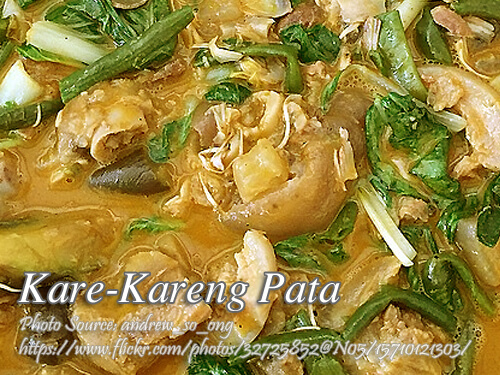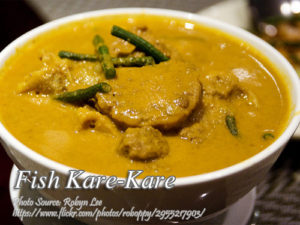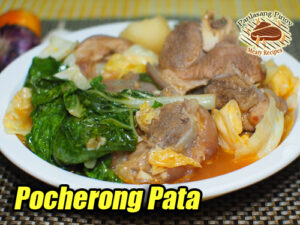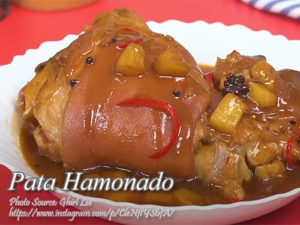This version of kare-kare is a variation of the original recipe that make use of the oxtail. This recipe I have here consists of pork hocks or pork pata as the main ingredient and of course the usual vegetables that are mixed in the dish. And this recipe does not use peanut butter which some people don’t like because of the slightly sweet taste when you mixed it in the dish.
But instead of using peanut butter, as in the authentic oxtail kare-kare, this recipe I have here is using ground peanuts and ground rice. To make it more appetizing, I suggest toasting the rice on an empty heated skillet for a few minutes before grinding. Don’t forget the shrimp paste or bagoong alamang when serving it because it is not complete if you omit it.
A Comforting Filipino Classic
Kare-kare is a beloved dish in Filipino cuisine, known for its rich and flavorful peanut sauce and the unique combination of tender meat and vegetables. While the traditional recipe uses oxtail, this version takes a different approach by using pork hocks or pata. This variation offers a delightful twist, retaining the essence of the dish while catering to those who prefer pork over beef.
A Unique Take on a Classic Dish
In this recipe, pork hocks take center stage, offering a slightly different texture and flavor profile compared to the more traditional oxtail. The result is a hearty and satisfying meal that remains true to the comforting nature of the original dish. The pork, with its tender meat and gelatinous skin, pairs perfectly with the creamy, savory sauce, creating a dish that’s both indulgent and familiar.
What sets this version apart is the choice of ingredients used to thicken the sauce. Unlike other recipes that call for peanut butter, this one opts for ground peanuts and ground rice, giving the dish a more authentic flavor. The absence of peanut butter also means there’s no risk of the sauce being overly sweet, a common concern for those who prefer their kare-kare on the savory side.
The Importance of Toasting Rice and Peanuts
One of the key steps in this recipe is toasting the rice before grinding it. Toasting the rice in a dry, heated skillet brings out its nutty flavor, adding depth to the sauce. This process also enhances the aroma of the dish, making it even more enticing as it cooks. The ground rice, combined with ground peanuts, thickens the sauce to a perfect consistency, ensuring that it clings to every piece of meat and vegetable.
Toasting the peanuts similarly deepens their flavor, contributing to the overall richness of the dish. This small but important step sets this recipe apart from others that rely solely on peanut butter for flavor.
A Brief History of Kare-Kare
Kare-kare has its roots in the culinary traditions of the Pampanga region in the Philippines, known as the country’s culinary capital. The dish is believed to have been introduced by the Kapampangan people, who are renowned for their love of rich, savory dishes. Originally, it was made with a variety of meats, including oxtail, tripe, and pork hocks, all simmered in a thick peanut sauce. Over time, different regions and households have put their spin on the recipe, resulting in the many variations we enjoy today.
The dish’s name is thought to be derived from the word “curry,” though tghe dish itself bears little resemblance to the Indian curry. The connection may lie in the use of similar spices and cooking techniques brought to the Philippines by Indian traders and laborers. However, it has evolved into a uniquely Filipino dish, distinct in its flavor and ingredients.
Cooking Kare-Kare: Step by Step
Preparing this dish is a labor of love, but the result is well worth the effort. The process begins with boiling the pork hocks until they become tender. This step is crucial for achieving the melt-in-your-mouth texture that is characteristic of a good pork hock dish. During the boiling process, any impurities that float to the surface are removed, ensuring a clean and clear broth.
Next, the vegetables—eggplants, sitaw (long beans), and pechay (bok choy)—are parboiled in salted water. This technique helps retain their vibrant color and crisp texture, preventing them from becoming mushy when added to the sauce later.
In a separate pan, garlic and onions are sautéed until fragrant. This mixture is then added to the pot with the boiled pork, along with atsuete (annatto) water, which gives the dish its signature orange hue. The atsuete seeds are steeped in water before being strained, ensuring that the color is evenly distributed throughout the sauce.
The final step involves adding the ground peanuts and toasted rice to the pot, which thickens the broth and enhances its flavor. A dash of patis (fish sauce) or salt is added to taste, rounding out the savory notes of the dish. The parboiled vegetables are then stirred in, and the dish is left to simmer for a few more minutes to allow the flavors to meld together.
The Essential Role of Shrimp Paste
No kare-kare is complete without a side of bagoong alamang, or shrimp paste. This salty, umami-rich condiment balances the mild, nutty flavor of the dish and provides a burst of flavor with every bite. Traditionally, bagoong is sautéed with garlic and onions to enhance its taste before serving. A spoonful of this savory paste on top of the sauce transforms the dish, bringing out the best in every ingredient.
A Dish Worth Sharing
It is more than just a meal; it’s a dish that brings people together. Whether it’s served during a festive occasion or as a special weekend treat, it’s a comforting reminder of home and heritage. This pork hock version offers a delicious alternative to the traditional oxtail, making it accessible to more people without sacrificing the depth of flavor that makes this dish a Filipino favorite. With each spoonful, you’ll experience the rich history and culinary artistry that has made the dish a staple in Filipino households for generations.
How to Cook Kare-Kareng Pata
Ingredients
- 1 kilo pork pata pork hocks, cut into 1 1/2 inch thick
- 2 pcs eggplants
- 1 bunch sitaw yard-long stringbeans
- 1 bunch pechay
- 1 head garlic minced
- 1 piece onion chopped
- 1 piece onion quartered
- 1/2 cup annato atchuete seeds steeped in half a cup of water
- 1/2 cup toasted peanuts
- 1/2 cup ground rice
- salt to taste or patis fish sauce
- cooking oil
- enough water to cover meat
Instructions
- Boil pork pata in water until the scum floats. Remove the scum and put the quartered onion. Boil until tender.
- Cut eggplants into serving pieces and the sitaw into 3-inch long pieces. Parboil both vegetables and the pechay in salted water, strain and set aside.
- Saute garlic and onions in oil in a preheated pan. Stir cook for at least 3 minutes. Then place into the pot of boiled pork pata. Mix well.
- Strain atchuete from the water it was steeped in. Discard the seeds. Add the atchuete water in the pot. You will notice that the color of the broth will turn to orange.
- Keep boiling and add ground peanuts and rice. Add patis or salt to taste.
- Add the parboiled vegetables. Bring to a boil for about 10 minutes.
- You can also serve this dish with ginisang bagoong or sauteed shrimp paste.
Notes
Cooking Tips:
Perfecting the Pork Shank
For the most tender Kare-Kareng Pata, simmer the pork shank in water with a bit of salt until it’s fall-off-the-bone tender. This slow cooking method helps render out excess fat and ensures the meat is juicy and flavorful. Don’t rush this process—patience is key to achieving that melt-in-your-mouth texture.Achieving the Ideal Peanut Sauce Consistency
To achieve a rich, smooth peanut sauce, blend the roasted peanuts until they form a fine paste before adding them to your stew. If the sauce turns out too thick, gradually stir in some reserved broth from the pork shank to reach your desired consistency. A good balance of thickness ensures the sauce clings perfectly to the meat and vegetables.Enhancing the Flavor with Annatto
For that signature vibrant color and subtle earthy flavor, use annatto seeds or annatto powder in your recipe. Soak the seeds in hot water to extract their color and flavor, then strain and add the annatto-infused liquid to the stew. This step not only adds depth to the flavor but also gives your Kare-Kareng Pata its classic golden hue.






Your recipe looks like an authentic kare-kare recipe because nowadays most people are using peanut butter or instant kare-kare mix. I must try this. Thanks!
Hi Fely, I’m glad you liked the recipe! Cheers!